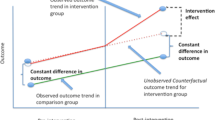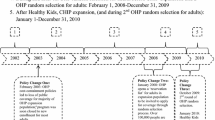Abstract
To determine if children eligible for coverage by the State Children’s Health Insurance Program (SCHIP) and Medicaid Programs were more likely to receive preventive dental visits after implementation of the SCHIP policy, retrospective cross-sectional analysis was done from the 1996–2000 Medical Expenditure Panel Surveys (MEPS) data. We linked the individual level data from the MEPS to state-level information on program eligibility. Using logistic regression models that adjust for the complex survey design, the association between SCHIP implementation and receipt of preventive dental care was examined for children aged 3–18 with family incomes ≤200% of the Federal Poverty Line (FPL). Children who were eligible for SCHIP/Medicaid coverage in their respective states were more likely to have received preventive care three years after SCHIP implementation than children with similar eligibility profiles prior to SCHIP implementation. SCHIP has successfully increased the proportion of eligible children receiving preventive dental care among children in families with incomes less than or equal to 200% FPL. Our findings indicate, however, that SCHIP needed time to mature before detecting significant effects on national level.


Similar content being viewed by others
References
Brown, E., Jr, & Manski, R. (2004) Dental services: use, expenses and sources of payment, 1996–2000. MEPS Research Findings #20. AHRQ Pub. No. 04–0018, Rockville, MD: Agency for Healthcare Research and Quality.
Flores, G., & Tomany-Korman, S. C. (2008). Racial and ethnic disparities in medical and dental health, access to care, and use of services in US children. Pediatrics, 121(2), e286–e298. doi:10.1542/peds.2007-1243.
Hughes, D. C., et al. (2005). Disparities in children’s use of oral health services. Public Health Rep, 120(4), 455–462.
Yu, S., et al. (2002). Factors that influence receipt of recommended preventive pediatric health and dental care. Pediatrics, 110(6), e73. doi:10.1542/peds.110.6.e73.
Crall, J. J. (2006). Access to oral health care: Professional and societal considerations. Journal of Dental Education, 70(11), 1133–1138.
((1396a(a)(10)(30)(A)), U.S·C.
Edelstein, B., et al. (2002). Child dental expenditure: 1996. Pediatric Dentistry, 24(1), 11–17.
Watson, M., & Macek D, M. R. (2001). The impact of income on children’s and adolescents’ preventive dental visits. The Journal of the American Dental Association, 132, 1580–1587.
National Center for Children in Poverty (NCCP).Basic facts about low-income children: birth to age 18. At: www.nccp.org/pub_lic.05. Accessed: November 8.
Newachek, P. W., et al. (2000). The unmet health needs of America’s children. Pediatrics, 106, 14–21. doi:10.1542/peds.106.1.14.
Gift, H. C., Reisine, S. T., & Larach, D. C. (1992). The social impact of dental problems and visits. American Journal of Public Health, 82, 1663–1668.
Cunningham, P. J. (2006). Medicaid/SCHIP cuts and hospital emergency department use. Health Affairs (Project Hope), 25(1), 237–247. doi:10.1377/hlthaff.25.1.237.
Edelstein, B. L. (1998). The cost of caring: Emergency oral health services. Arlington, VA: National Center for Education in Maternal and Child Health.
Federico, S., Tjoeng, H., & Berman, S. (2007). State strategies to reduce the number of uninsured children. The Journal of Pediatrics, 151(5, Suppl), S28–S31. doi:10.1016/j.jpeds.2007.08.017.
Vistnes, J. P., & Schone, B. S. (2008). Pathways to coverage: the changing roles of public and private sources. Health Affairs (Project Hope), 27(1), 44–57. doi:10.1377/hlthaff.27.1.44.
US Department of Health and Human Services (2000) Oral health in America: A report of the Surgeon General. Rockville, MD: US Department of Health and Human Services, National Institutes of Health publications.
Tommy, G (2002) Thompson, Secretary of health and human services, report to congress: The state children’s health insurance program: A summary evaluation of states’ early experience with SCHIP.
Lo Sasso, Anthony, T., Buchmueller, & Thomas, C. (2002) The effect of the state children’s health insurance program on health insurance coverage. NEBR Working Paper 9405.
Wang, H., Norton, E. C., & Rozier, R. G. (2007). Effects of the state children’s health insurance program on access to dental care and use of dental services. Health Services Research, 42(4), 1544–1563. doi:10.1111/j.1475-6773.2007.00699.x.
Brickhouse, T. H., Rozier, R. G., & Slade, G. D. (2006). The effect of two publicly funded insurance programs on use of dental services for young children. Health Services Research, 41(6), 2033–2053. doi:10.1111/j.1475-6773.2006.00586.x.
Brickhouse, T. H., Rozier, R. G., & Slade, G. D. (2008). Effects of enrollment in medicaid versus the state children’s health insurance program on kindergarten children’s untreated dental caries. American Journal of Public Health, 98(5), 876–881. doi:10.2105/AJPH.2007.111468.
Rosenbach, M. et al. (2001) Implementation of the state children’s health insurance program: Momentum is increasing after a modest start (First annual report) Cambridge, MA: Mathematica Policy Research, Inc.
American Academy of Pediatrics (2001) A guide to children’s dental health (online). [cited 2001 December 26]; Available from: www.medem.com/MedLB/article_detaillb.cfm?article_ID=ZZZJPK5BDDC&sub_cat=11.
Cohen, J. (1997). Design, methods of the medical expenditure panel survey household component. MEPS methodology report no. 1. Rockville, MD: Agency for Health Care Policy and Research.
Liu, C. L., et al. (2005). Continuity of health insurance coverage for children with special health care needs. Maternal and Child Health Journal, 9(4), 363–375. doi:10.1007/s10995-005-0019-1.
Ganz, M. L., Xuan, Z., & Hunter, D. G. (2006). Prevalence and correlates of children’s diagnosed eye and vision conditions. Ophthalmology, 13(12), 2298–2306. doi:10.1016/j.ophtha.2006.06.015.
Heck, K. E., & Parker, J. D. (2002). Family structure, socioeconomic status, and access to health care for children. Health Services Research, 37(1), 173–186.
Doorslaer, E., and Masseria, C. (2004) Income-related inequality in the use of medical care in 21 oecd countries, in organisation for economic co-operation and development health working paper no. 14: France.
Stata statistical software. Release 8.1. 2003,College Station, TX: Stata Corporation.
Center for Financing (December, 2003). Access and Cost Trends, MEPS HC-036: 1996–2001 Pooled Estimation File. Rockville, MD: Agency for Healthcare Research and Quality.
Rao, J. N. K., & Scott, A. J. (1984). On chi-squared tests for multiway contingency tables with cell proportions estimated from survey data. Annals of Statistics, 12, 46–60. doi:10.1214/aos/1176346391.
Cochran, W. G. (1977). Sampling techniques (3rd ed.). New York: John Wiley and Sons.
Korn, E. L., & Graubard, B. I. (1991). Epidemiologic studies utilizing surveys: accounting for the sampling design. American Journal of Public Health, 81(9), 1166–1173.
Rubin, D. B. (1996). Multiple imputation after 18+ years. Journal of the American Statistical Association, 91, 473–489. doi:10.2307/2291635.
Schafer, J. L. (1999). Multiple imputation: A primer. Statistical Methods in Medical Research, 8, 3–15. doi:10.1191/096228099671525676.
Mayer, M. I., et al. (2000). The effects of Medicaid Expansions and reimbursement increases on dentists’ participation. Inquiry, 37, 33–44.
Herndon, J. B., et al. (2008). The effect of premium changes on SCHIP enrollment duration. Health Services Research, 43(2), 458–477. doi:10.1111/j.1475-6773.2007.00777.x.
Acknowledgment
This study was supported by Maternal and Child Health Training Grant, Harvard School of Public Health, and Data Center at C group in Agency of Healthcare Research and Quality. We thank Professor Katherine Swartz for her comments and inputs for this study.
The project contents are solely the responsibility of the authors and do not necessarily represent the official views of the Agency for Healthcare Research and Quality or Executive Office of Health and Human Services, The Commonwealth of Massachusetts.
Author information
Authors and Affiliations
Corresponding author
Rights and permissions
About this article
Cite this article
Liao, CC., Ganz, M.L., Jiang, H. et al. The Impact of the Public Insurance Expansions on Children’s Use of Preventive Dental Care. Matern Child Health J 14, 58–66 (2010). https://doi.org/10.1007/s10995-008-0432-3
Received:
Accepted:
Published:
Issue Date:
DOI: https://doi.org/10.1007/s10995-008-0432-3
Keywords
- Dental care
- State children health insurance program
- Utilization
- Medical expenditure panel survey
- MEPS
- Adolescent
- Child
- Child health services
- Eligibility determination
- Health services accessibility
- Health status
- Insurance coverage
- Medicaid
- Uninsured
- Poverty
- Preventive care
- State health plans
- United States
- Vulnerable populations




